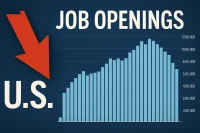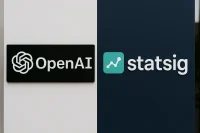Small Business Hiring Crisis Deepens Despite Strong June Jobs Report
The American economy continues to show resilience in the face of economic uncertainty, with the June Jobs Report revealing better-than-expected numbers. Employers added 147,000 new jobs, slightly up from May’s 144,000, and the unemployment rate fell to 4.1% from 4.2%. However, beneath these seemingly positive statistics lies a troubling reality for small business owners across the nation.
According to the latest survey from the National Federation of Independent Business (NFIB), an astonishing 86% of small business owners reported few or no qualified applicants for their open positions. This hiring challenge has become the top problem facing small businesses, creating a paradoxical situation where unemployment remains relatively low while job openings go unfilled.
“We’re seeing an increased struggle in the labor market,” explains Sarah Horn, Assistant Texas State Director of the NFIB. “58% of small business owners reported trying to hire in June, up three points from our May report.”
This labor shortage is affecting multiple sectors, including restaurants, manufacturing, construction, and transportation—industries critical to the continued growth of local economies across the country.
Learn more about national labor market trends
Restaurant Industry Hit Hardest by Small Business Hiring Challenges
The restaurant industry continues to face some of the most severe small business hiring challenges in the current economy. Despite significant wage increases and enhanced benefits packages, owners struggle to find qualified workers willing to fill positions.
Desperate Measures: Wage Increases and Benefits Fail to Attract Qualified Workers
Lewis Rainey, owner of Duncanville Pelican House Restaurant, exemplifies the frustration felt by many small business owners: “We have 16 interviews for next week. Maybe two of them would be halfway qualified.”
Rainey reports raising wages by 30% since 2019, offering healthcare benefits, and providing free meals to employees. Despite these incentives, finding qualified staff remains an uphill battle.
“You get a ton of applications, but you don’t get the qualified workers that you’re looking for in this industry,” Rainey explains.
This experience isn’t isolated to restaurants. The NFIB survey reveals similar hiring difficulties across multiple sectors:
- Manufacturing: Skilled trade positions remain unfilled despite competitive wages
- Construction: Despite visible growth and development across regions like North Texas
- Transportation: Delivery and logistics companies struggle to maintain adequate staffing
The Economic Impact of Persistent Small Business Hiring Challenges
The inability to adequately staff businesses creates a cascade of negative effects:
- Reduced operating hours limiting revenue potential
- Existing staff burnout leading to higher turnover
- Decreased customer satisfaction due to service limitations
- Constrained business growth and expansion opportunities
- Increased pressure to implement automation solutions
For small businesses operating on thin margins, these effects can be particularly devastating, potentially forcing closures in communities that can least afford to lose local employers.
Explore the economic impact of labor shortages on small businesses
Legislative Solutions to Small Business Hiring Challenges
Recognizing the severity of these hiring challenges, state and federal legislators are exploring various solutions to address the labor shortage affecting small businesses.
Texas Takes Action: New Legislation to Attract Skilled Workers
The Texas Legislature has recently passed a bill aimed at making it easier to bring skilled workers from other states to fill key positions in Texas businesses. This interstate mobility initiative could help alleviate some of the pressure on industries facing critical staffing shortages.
“The legislature passed a bill this session that will make it easier to bring skilled workers to Texas from other states to fill key positions,” Horn explains, highlighting how state-level action might provide some relief.
Immigration Reform: A Potential Solution to Labor Shortages
Both the Texas and National Restaurant Associations have appealed to President Donald Trump to provide immigration relief for workers with no criminal records who pose no threat to national security. These industry groups argue that such workers are already integral to the economy.
“We have people who are all throughout our economy, especially in Texas, and they’re law-abiding. They’re paying taxes. They’re contributing, filling critical roles that are going unfilled otherwise,” a representative stated.
This approach recognizes the significant role immigrant workers play in many industries facing severe small business hiring challenges, particularly in sectors like hospitality, agriculture, and construction.
Tax Relief: Another Approach to Supporting Small Businesses
Beyond addressing labor shortages directly, some policy proposals aim to ease the financial burden on small businesses struggling with hiring challenges.
Proposed Business Property Tax Exemption Increase
The NFIB is advocating for voters to approve a proposal in November that would substantially raise the business property tax exemption in Texas from $2,500 to $125,000. According to Sarah Horn, this tax relief “would go a long way in giving small businesses breathing room” as they navigate the difficult hiring landscape.
This type of tax relief could:
- Free up capital for higher wages and benefits to attract workers
- Allow investment in training programs for less-qualified applicants
- Provide financial stability during periods of understaffing
- Enable technology investments to increase productivity with fewer workers
- Support business sustainability during prolonged hiring challenges
Find small business jobs in your area
Innovative Strategies Small Businesses Are Using to Overcome Hiring Challenges
While legislative solutions may provide long-term relief, small business owners are implementing creative strategies to address their immediate hiring challenges.
Rethinking Recruitment: Beyond Traditional Hiring Approaches
Forward-thinking small businesses are exploring alternative recruitment methods to find qualified workers:
- Partnering with local community colleges for direct pipeline programs
- Creating apprenticeship opportunities to train workers from the ground up
- Targeting semi-retired professionals for part-time specialized roles
- Implementing employee referral bonuses to leverage existing staff networks
- Exploring untapped labor pools such as veterans, people with disabilities, and formerly incarcerated individuals
Technology Solutions: Doing More with Fewer Workers
Small businesses are increasingly turning to technology solutions to maintain operations with smaller teams:
- Point-of-sale systems that streamline ordering and payment processes
- Scheduling software to optimize staff allocation during peak hours
- Customer self-service options to reduce service staff requirements
- Automated inventory management to reduce back-office labor needs
- Digital marketing tools that deliver better results with less manual effort
Community-Based Approaches to Small Business Hiring Challenges
Some small business owners are finding success by deepening their community connections:
- Partnering with local high schools for work-study programs
- Creating flexible schedules for parents and caregivers
- Offering transportation assistance to expand the potential hiring radius
- Developing shared employee programs with complementary businesses
- Building stronger local business networks for collaborative solutions
Hiring?
Connect With Motivated Workers During This Small Business Hiring Challenge
Are you among the 86% of small businesses struggling to find qualified applicants? Post your job openings on a platform designed to connect small businesses with motivated, qualified candidates.
📢 Post Jobs for Free with WhatJobsThe Future Outlook for Small Business Hiring Challenges
The persistent nature of these hiring challenges suggests that the labor market has undergone structural changes that may require fundamental adjustments in how small businesses approach staffing.
Long-Term Trends Affecting Small Business Labor Markets
Several factors are likely to influence small business hiring challenges in the coming years:
- Demographic shifts as Baby Boomers retire without sufficient replacement workers
- Changing worker expectations regarding flexibility, benefits, and work-life balance
- Skills mismatches between available workers and needed positions
- Geographic disparities in population growth and economic opportunity
- Technological disruption changing the nature of work across industries
Adapting to the New Normal: Sustainability Amid Ongoing Hiring Challenges
For many small business owners like Lewis Rainey, the focus has shifted from solving the hiring crisis to adapting to it: “We got to do what we got to do and just serve our folks, that’s all.”
This pragmatic approach recognizes that while the search for qualified workers continues, businesses must find ways to operate effectively with the resources available to them. This might include:
- Streamlining product/service offerings to match available staff capacity
- Cross-training existing employees to increase operational flexibility
- Adjusting business hours to optimize staff utilization
- Implementing technology solutions where feasible
- Developing stronger retention strategies to keep existing qualified staff
The Economic Paradox: Low Unemployment Yet Unfilled Positions
The current economic situation presents a puzzling contradiction: despite relatively low unemployment rates, small businesses continue to struggle with filling positions. This paradox highlights deeper issues within the labor market that simple employment statistics fail to capture.
Beyond the Numbers: Why Small Business Hiring Challenges Persist Despite Low Unemployment
Several factors contribute to this seemingly contradictory situation:
- Skills mismatch: Available workers lack the specific skills needed for open positions
- Geographic disparities: Workers and jobs are not always in the same locations
- Changing worker priorities: Post-pandemic shifts in work preferences and expectations
- Industry-specific challenges: Some sectors face particularly acute hiring difficulties
- Wage competition: Small businesses often cannot match corporate compensation packages
This complex situation requires nuanced solutions that address not just employment numbers but the qualitative aspects of the labor market that affect small business hiring challenges.
FAQ: Understanding Small Business Hiring Challenges
Why are small businesses facing such severe hiring challenges despite low unemployment rates?
Small business hiring challenges persist despite low unemployment because of several factors including skills mismatches, changing worker expectations, and wage competition from larger employers. The NFIB survey found that 86% of small business owners reported few or no qualified applicants for their open positions, indicating that the available labor pool doesn’t align with the specific needs of small businesses. Additionally, many workers now prioritize flexibility, benefits, and work-life balance in ways that some small businesses struggle to accommodate, further complicating the hiring landscape.
What industries are most affected by small business hiring challenges?
The small business hiring challenges are particularly acute in restaurants, manufacturing, construction, and transportation industries. Restaurant owners like Lewis Rainey report receiving many applications but finding very few qualified candidates despite offering 30% higher wages since 2019, healthcare benefits, and free meals. Similarly, manufacturing businesses struggle to fill skilled trade positions, construction companies face labor shortages despite visible growth across regions like North Texas, and transportation companies cannot maintain adequate staffing levels. These industries often require specific skills or involve working conditions that make recruitment particularly difficult in the current labor market.
What solutions are being proposed to address small business hiring challenges?
Several solutions are being proposed to address small business hiring challenges, including legislative action, immigration reform, and tax relief. The Texas Legislature recently passed a bill to facilitate bringing skilled workers from other states to fill key positions. Additionally, industry groups like the Texas and National Restaurant Associations are advocating for immigration relief for law-abiding workers who are already contributing to the economy. On the tax front, there’s a proposal to increase the business property tax exemption in Texas from $2,500 to $125,000, which would provide financial breathing room for small businesses struggling with hiring and retention.
How are small businesses adapting to persistent hiring challenges?
Small businesses are adapting to hiring challenges through various innovative strategies including rethinking recruitment methods, implementing technology solutions, and adopting community-based approaches. Many are creating direct pipeline programs with community colleges, developing apprenticeship opportunities, and targeting semi-retired professionals for specialized roles. Technology adoption has increased, with businesses implementing point-of-sale systems, scheduling software, and customer self-service options to operate efficiently with smaller teams. Some businesses are also adjusting their operations fundamentally—streamlining offerings, cross-training existing staff, modifying business hours, and focusing intensely on retention of current qualified employees.




